Key takeaways:
- Pandemic fatigue encompasses mental, emotional, and physical exhaustion due to prolonged uncertainty, affecting daily tasks and well-being.
- Establishing a consistent routine and incorporating nature into daily life can significantly help in overcoming fatigue.
- Building a solid support system through friendships and community engagement provides emotional strength and a sense of belonging.
- Maintaining long-term well-being involves self-care practices, digital detoxes, and engaging in purposeful activities, such as volunteering.
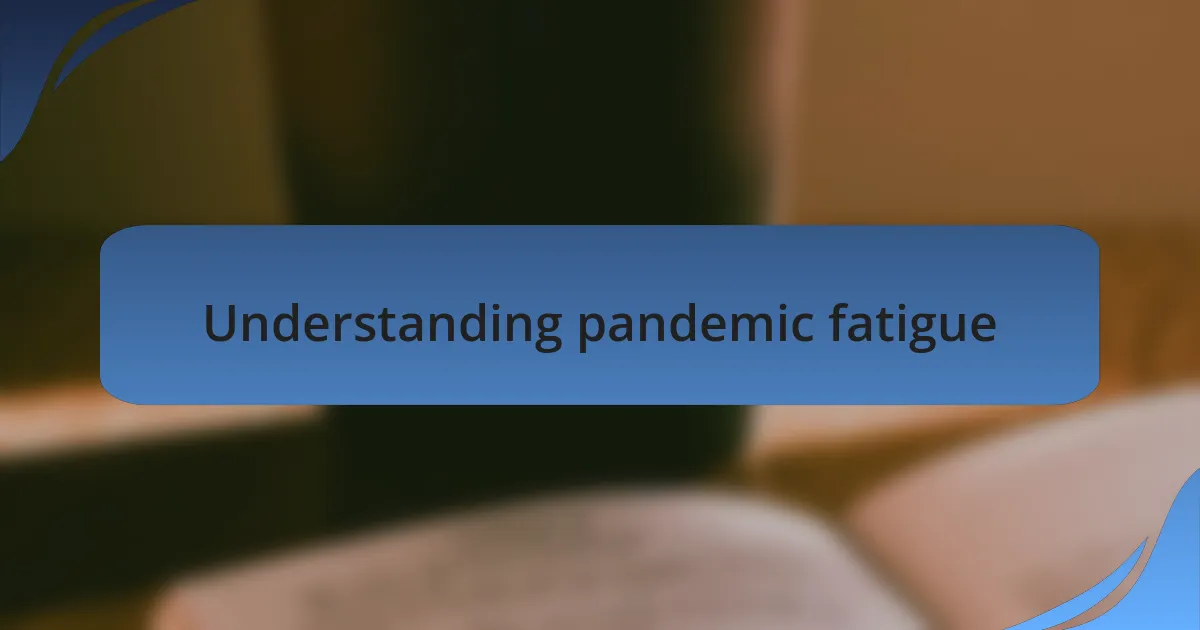
Understanding pandemic fatigue
Pandemic fatigue is a term that encapsulates the exhaustion many of us have felt during these prolonged periods of uncertainty and change. I remember a time when simply deciding what to have for dinner felt overwhelming. It was as if the mundane tasks of daily life had transformed into monumental challenges, leaving me questioning, “Why does everything feel so hard right now?”
This fatigue isn’t just about physical tiredness; it’s a mental and emotional weariness that creeps into our lives. Sometimes, I found myself staring at my computer screen for hours, feeling drained yet unable to focus. Have you ever felt that way, where even your favorite activities lost their charm? That’s the weight of pandemic fatigue, manifesting as a sense of disconnection and sadness.
Moreover, the constant stream of news and updates can amplify this sense of fatigue. I recall scrolling through social media, seeing endless posts about rising cases and restrictions, which only heightened my feelings of anxiety. It made me wonder, how much information is too much? Understanding pandemic fatigue means recognizing that it’s okay to feel overwhelmed, and that acknowledging these feelings is the first step toward finding ways to cope.
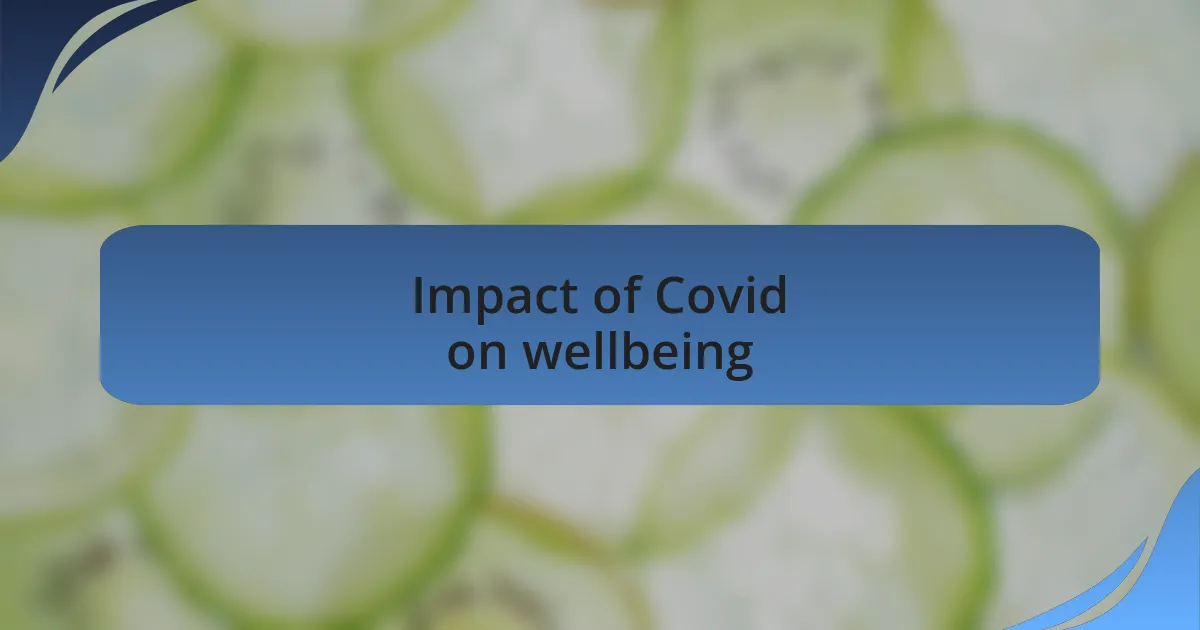
Impact of Covid on wellbeing
The pandemic has undeniably cast a long shadow on our overall wellbeing. For me, there were days when my motivation simply vanished—I found myself skipping my morning routine and staying in pajamas far longer than I ever would have pre-pandemic. Have you ever noticed how your energy levels fluctuate based on the news? When discussions turned to vaccine rollouts or new variants, I felt a mix of relief and anxiety, highlighting how external events can directly impact our mental state.
Isolation played a huge role in my struggle with wellbeing. I remember video calls with friends that often felt forced, leaving me yearning for the authentic connections we once took for granted. It was during these moments of forced interaction that I realized how much I valued the simple joy of sharing space, a cup of coffee, and laughter without a screen separating us. Isn’t it strange how something as basic as human connection can suddenly feel like a luxury?
Additionally, I couldn’t help but notice the effects on my physical health, too. The stress and uncertainty led to late-night snacking and skipped workouts; I often caught myself justifying these habits as coping mechanisms. Reflecting on this now, I wonder how many others faced similar challenges. It’s easy to slip into unhealthy patterns when the world feels unstable, and recognizing these changes is crucial for reclaiming our wellbeing amidst the chaos.
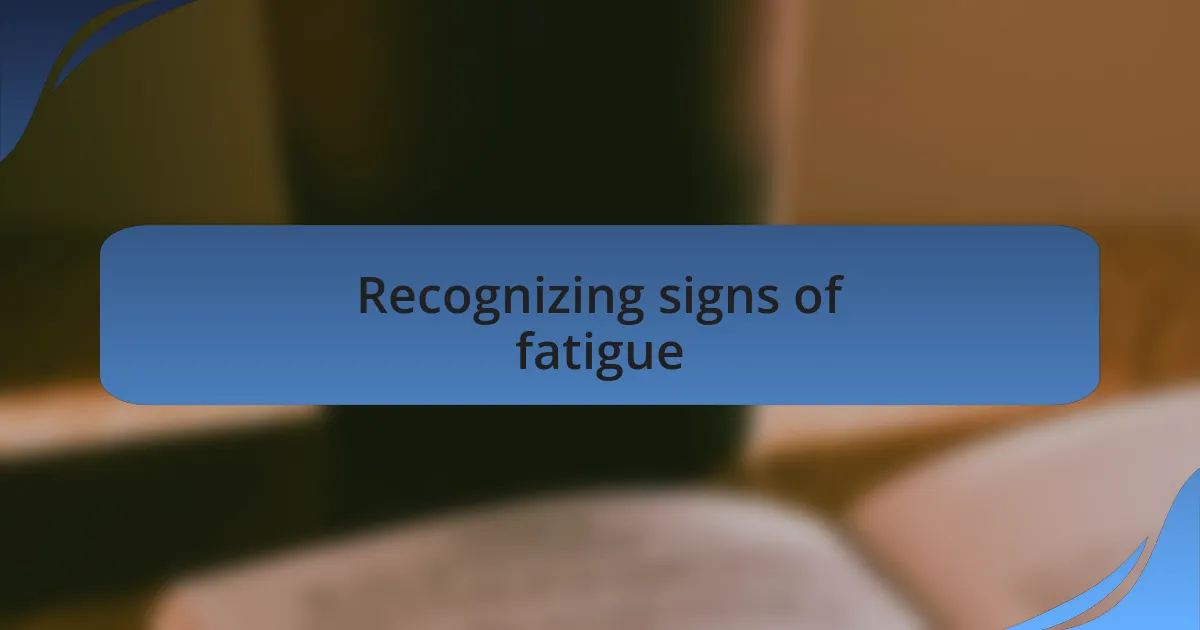
Recognizing signs of fatigue
As I navigated the pandemic, I started to notice some telltale signs of fatigue creeping in. Simple tasks, like getting out of bed or engaging in hobbies I once loved, began to feel burdensome. Has that ever happened to you? I found myself questioning whether I was simply being lazy or if there were deeper underlying issues at play.
Another sign emerged in my emotional responses. I would find myself feeling easily overwhelmed by minor inconveniences. One day, after a long week, a spilled cup of coffee sent me into a spiral of frustration. It’s fascinating how our emotional resilience can be chipped away without us even realizing it, isn’t it? Recognizing these waves of heightened sensitivity was a crucial step for me in acknowledging my fatigue.
Physically, my body also began to communicate its exhaustion. I noticed a persistent heaviness in my limbs, coupled with a nagging headache that seemed to echo my mental state. There were days when the thought of even a short walk felt daunting. How often do we overlook these physical cues, thinking they’re just a part of life? Paying attention to these signs helped me understand that fatigue comes not only from our minds but from our bodies, too.
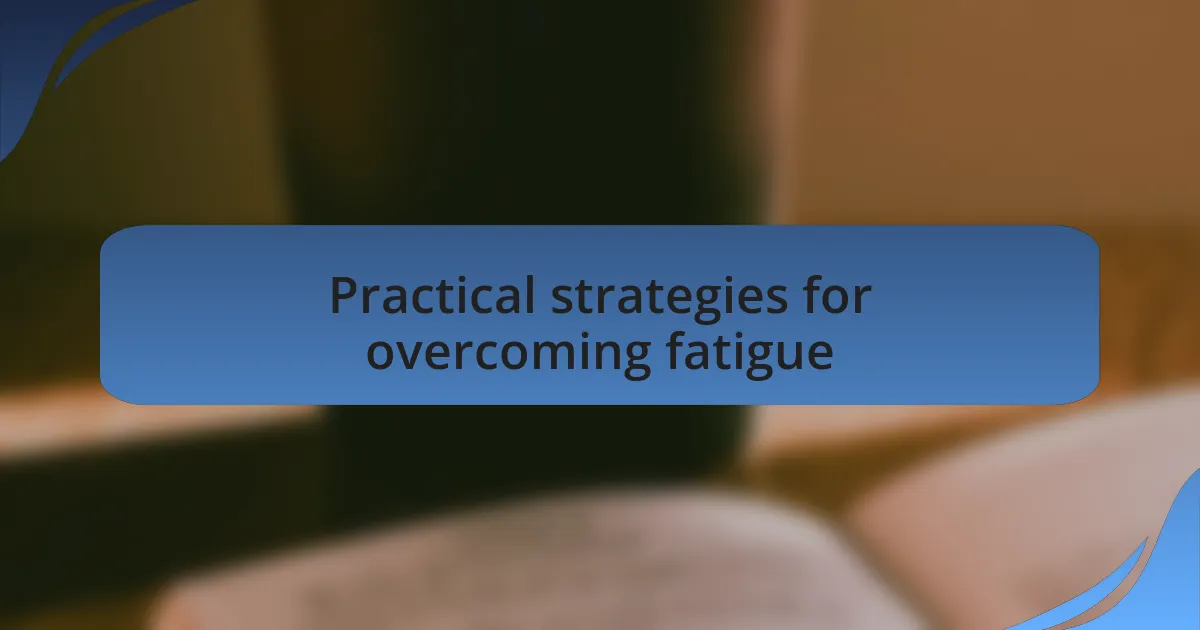
Practical strategies for overcoming fatigue
One practical strategy that really helped me was establishing a consistent routine. I started to wake up and go to bed at the same time every day, even on weekends. It might sound simple, but having that predictability created a sense of normalcy and made a significant difference in my energy levels. I wondered if others might find this helpful too—has sticking to a routine worked for you?
Incorporating short breaks throughout my day became another key tactic in combating fatigue. I would set a timer for 25 minutes of focused work, followed by a 5-minute break to stretch or grab a glass of water. This method, known as the Pomodoro Technique, allowed me to recharge mentally and physically. The small moments of pause felt refreshing, and I realized that giving myself permission to step away from tasks was both liberating and energizing.
Finally, I found that reconnecting with nature was incredibly revitalizing. Taking walks in my neighborhood or simply sitting outside for a few minutes helped me reset my mental space. I could hear the birds chirping and feel the fresh air on my face, which reminded me of the world’s simple joys. When was the last time you took a moment to appreciate your surroundings? For me, these small yet significant breaks nourished my spirit and helped clear the fog of fatigue clouding my mind.
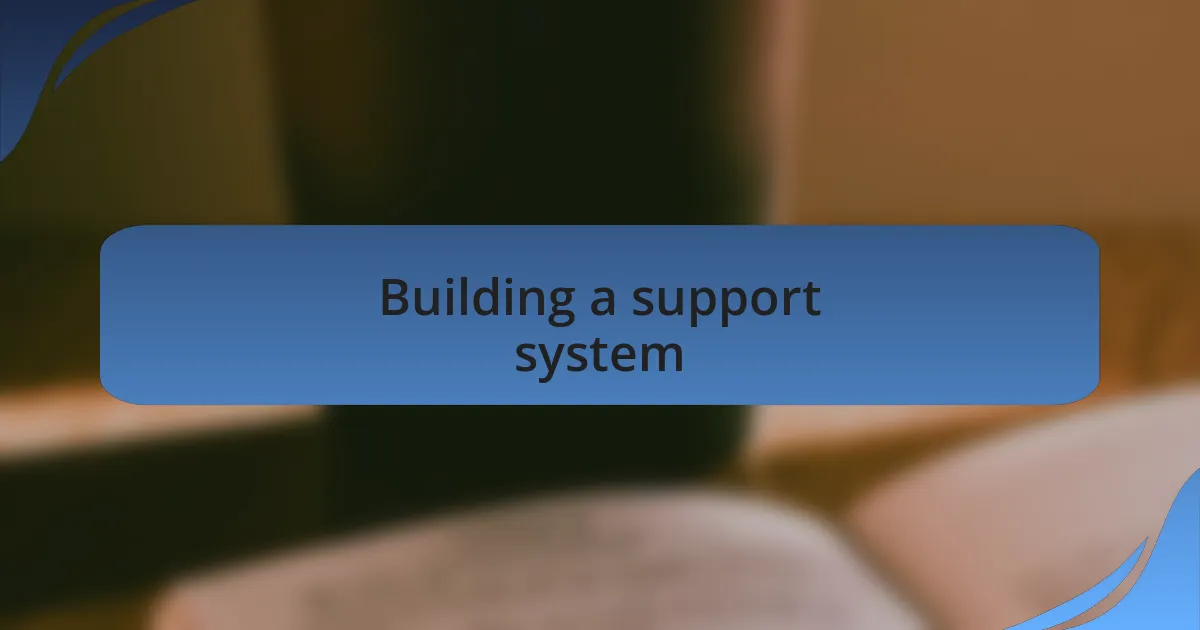
Building a support system
Having a solid support system became a crucial element in my journey to overcome pandemic fatigue. I started reaching out to friends and family regularly, sharing not just how I felt but also my daily experiences. I remember a moment when a simple phone call with a friend turned into a heartfelt conversation about our struggles, reminding me that I wasn’t alone. Have you thought about how just talking can create such a strong connection?
I also made it a point to engage with community groups, both online and offline, which broadened my support network. Joining a virtual book club was a highlight; it connected me with people who shared similar interests and, more importantly, provided a sense of belonging. I often felt uplifted after these discussions, realizing the power of shared stories and collective experiences. Do you have a group or community where you feel supported?
On some days, when the weight of the world felt heavy, simply knowing I had friends or groups to lean on made it easier to push through. I learned that vulnerability could be a source of strength. By allowing myself to express my feelings to others, I discovered that many shared my experiences and emotions. Isn’t it comforting to realize that sharing our burdens can sometimes lighten the load? Those connections are a reminder that we can nurture our well-being together, even from a distance.
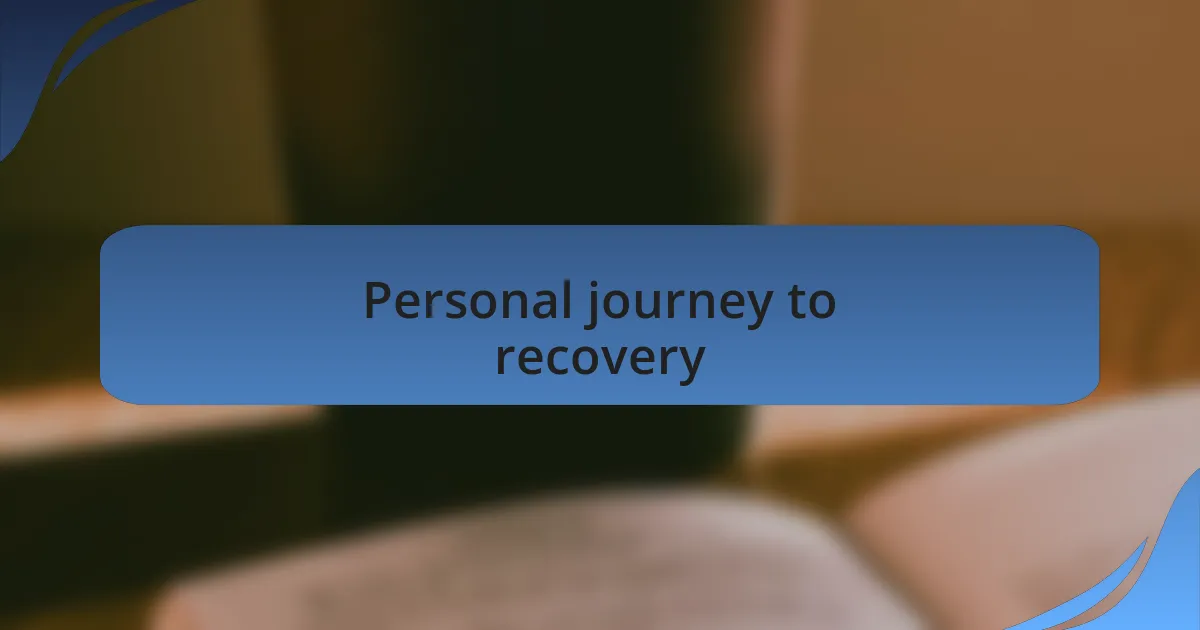
Personal journey to recovery
Finding my path to recovery was not an overnight process; it was a gradual unfolding. I vividly recall a weekend when I decided to step outside for a walk after weeks of feeling cooped up. The fresh air felt like a breath of life, and as I strolled through the park, I allowed myself to reflect on my emotions. Have you ever noticed how nature can be a catalyst for healing? It was in that moment of stillness among the trees that I began to feel the fog of fatigue start to lift, if only slightly.
Incorporating daily routines became essential for my recovery. I remember the first time I set aside time for mindfulness meditation. Initially, I struggled to quiet my racing thoughts, but as I practiced, I began to embrace a newfound sense of peace. This simple act of carving out space for myself felt revolutionary. Have you found any rituals that help you center your thoughts? I discovered that these small, intentional practices could weave moments of calm into an otherwise hectic day, providing a rhythm for my recovery.
As I moved further along my journey, celebrating small victories became crucial. I still remember the joy of cooking a meal from scratch after months of relying on takeout. The act itself was therapeutic, combining creativity with a sense of accomplishment. What’s a simple pleasure that has made a difference in your life? By focusing on these positive experiences, I started to build a sense of normalcy and joy amid the chaos, fueling my overall well-being.
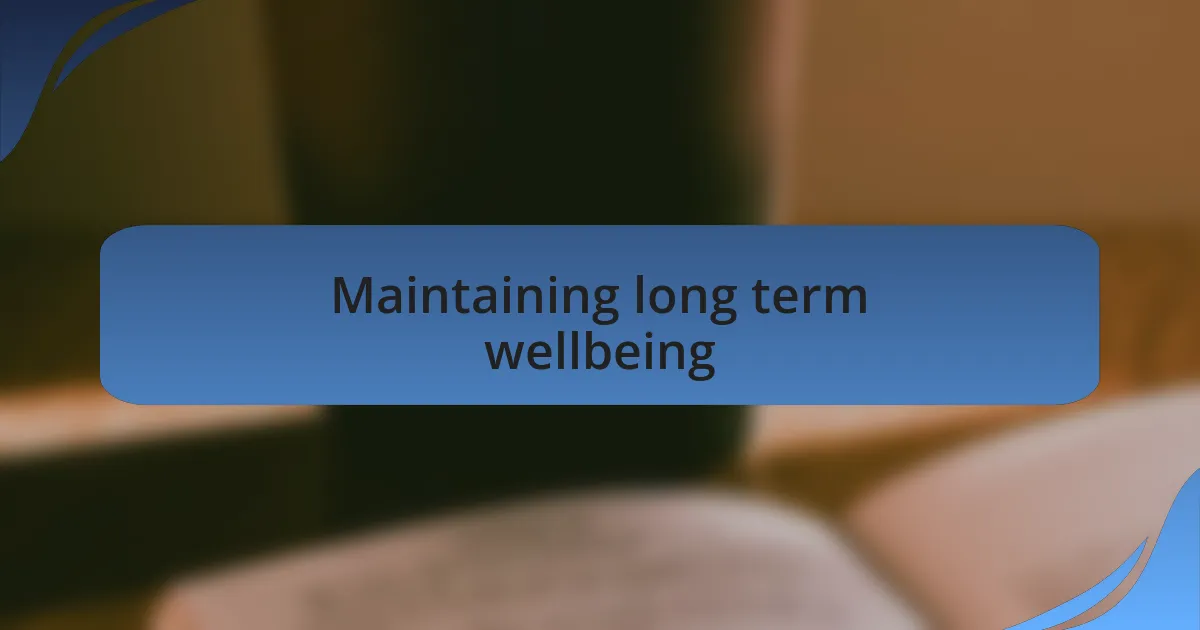
Maintaining long term wellbeing
Finding ways to maintain long-term wellbeing often requires a commitment to balance and self-care. I recall a period when I established a weekly digital detox, where I completely unplugged from screens. The silence felt foreign at first, but within days, I started to notice how clarity crept back into my mind. Have you ever felt that rush of creativity when distractions fade away? In those moments, I rediscovered hobbies I hadn’t engaged in for years, like painting and journaling, which brought me immense joy.
Another cornerstone of my wellbeing routine became regular check-ins with friends and family. I vividly remember a virtual coffee catch-up with my sister during particularly tough weeks. Sharing our struggles and laughter lifted a weight off my shoulders, reminding me I wasn’t alone in this journey. Isn’t it amazing how connection can ignite a sense of belonging? These interactions became essential, helping me fortify my emotional health by reinforcing a community of support around me.
I realized that maintaining long-term wellbeing also meant fostering a sense of purpose. For me, volunteering at a local food bank was a turning point. Engaging with the community made the world feel smaller and more interconnected. Have you considered how contributing to something greater than ourselves can spark joy? This experience not only enriched my life but also grounded me, cultivating gratitude that permeated other areas of my wellbeing.